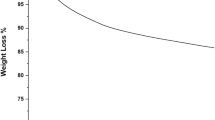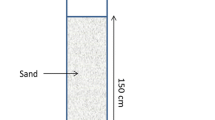Abstract
The removal of heavy metals from wastewater by using activated alumina or chitosan as adsorbers was evaluated. Cd(II) and Cr(III) were employed as models of the behaviour of divalent and trivalent metal ions. The adsorption of Cd(II) and Cr(III) onto the adsorbers evaluated was studied as a function of pH, time, amount of adsorber, concentration of metal ions and sample volume. A 0.4-g portion of activated alumina can retain 0.6 mg Cr(III) and 0.2 mg Cd(II) from 20 mL sample adjusted at pH 4 and stirred for 30 min. It is therefore possible to totally decontaminate 500 mL of a waste containing 5 mg L−1 Cd(II) and Cr(III) with 10 g alumina. On the other hand, 0.4 g chitosan can totally decontaminate 20 mL of a pH 5 solution containing up to 50 mg L−1 Cd(II) and Cr(III). A 99.2±0.1% retention of Cd(II) and 83±1% retention of Cr(III) was obtained from 500 mL of a laboratory waste. The aforementioned strategies were applied for the minimization of analytical chemistry teaching laboratories and atomic spectrometry laboratory wastes. On comparing both adsorbers it can be concluded that chitosan is more preferable than alumina due to the reduced price of chitosan and the absence of side-pollution effects.





Similar content being viewed by others
References
Carbonell V, Salvador A, de la Guardia M (1992) Fresenius J Anal Chem 342:529–537
Marqués MJ, Morales Rubio A, Salvador A, de la Guardia M (2001) Talanta 53:1229–1239
Pannain MC, Santelli RE (1995) Talanta 42:1609
Cooper C, Jiang JQ, Ouki S (2002) J Chem Technol Biotechnol 77:546–551
Bailey SE, Olin TJ, Bricka RM, Adrian DD (1999) Water Res 33:2469–2479
Kapoor A, Viraraghavan T (1998) J Environ Eng Asce 124:1020
Jeong SY, Lee JM (1998) Bull Korean Chem Soc 19:218
Stirk WA, Van Staden J (2000) Botanica Marina 43:467
Zouboulis AI, Matis KA, Lazaridis NK (2001) Sep Sci Technol 36:349
Ricon P, Lecuyer J, LeCloirec P (1998) Environ Technol 19:1005–1016
Dahbi S, Azzi M, de la Guardia M (1999) Fresenius J Anal Chem 363:404–407
Tseng RL, Wu FC, Juang RS (1999) J Environ Sci Health Part A 34:1815–1828
Schmuhl R, Krieg HM, Keizer K (2001) Water SA 27:1–7
Danubies L, Guimon C, Yiaconmi S, Guibol E (2001) Colloids Surf A 177:2–3
Dantas TND, Neto AAD, Moura MCP, Neto ELB, Telemaco ED (2001) Langmuir 17:4256–4260
Kaminski W, Modrzejewska Z (1997) Sep Sci Technol 32:2659–2668
Kawamura Y, Yoshida H, Asai S, Kurahashi I, Tanibe H (1997) Sep Sci Technol 32:1959–1974
Bang SS, Pazirandeh M (1999) J Microencap 16:489–499
Bassi R, Prasher SO, Simpson BK (1999) Environ Technol 20:1177–1182
Bassi R, Prasher SO, Simpson BK (2000) Sep Sci Technol 35:547
Jansson Charrier M, Guibal E, Roussy J, Surjous R (1996) Water Sci Technol 34:169
Minamisawa M, Nakajima S, Mitsue Y, Miyazawa K, Ueno K, Hatori A, Miyajima S, Hoshino M, Yoshida S, Takai N (2002) Nippon Kagaka Kaishi 459–461
Acknowledgements
Authors acknowledge the financial support of the Dirección General de Enseñanza Superior e Investigación Científica Project No. PB98–0947-C02–02 and of the Ministerio de Ciencia y Tecnología Project No. AGL2002–00729. M.C.A. acknowledges the grant from the Delegación de Medioambiente of the University of Valencia for studies on academic residue minimization. We also thank Miss I.E. Martí-Herrero and J. López-Burguete for their collaborative work.
Author information
Authors and Affiliations
Corresponding author
Rights and permissions
About this article
Cite this article
Luisa Cervera, M., Carmen Arnal, M. & de la Guardia, M. Removal of heavy metals by using adsorption on alumina or chitosan. Anal Bioanal Chem 375, 820–825 (2003). https://doi.org/10.1007/s00216-003-1796-2
Received:
Revised:
Accepted:
Published:
Issue Date:
DOI: https://doi.org/10.1007/s00216-003-1796-2




